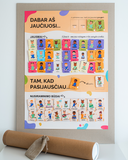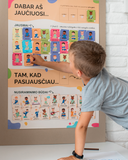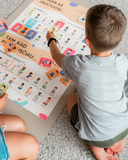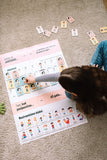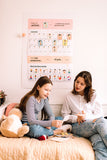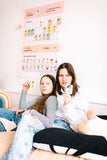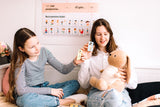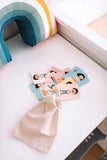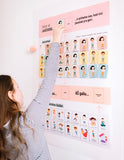– 27 laminated cards of emotions and feelings, which teach both children and adults to recognize and name their own emotions and feelings and those of others.
– 18 laminated calming cards-methods that help the child not only to visually see the possibilities of releasing feelings, to choose the most suitable method at that time, but also encourage independent self-regulation.
– 5 laminated blank cards for your discovered new ways of calming down or emotions.
– A linen bag to store cards when necessary.
– Reusable velcro double-sided stickers for attaching cards to the poster.
RECOMMENDATIONS FOR USE:
We have been using emotion cards in our family since birth, so my 1.5-year-old daughter has already distinguished between her own and others' main feelings. She is currently 3.5 years old, we each recognize about half of the feelings listed on the poster, we have discovered our own way of calming down when anger and sadness set in (it took us about a couple of weeks to work intensively on the poster), but we do all this TOGETHER. Small children need co-regulation with the help of another person, so the "Knowledge of Emotions and Calming Corner" first of all helps us, PARENTS and CAREGIVERS, to calm down and thus maintain a safe space of peace for them, trust that they can go through their feelings, develop a suitable example, emotions coping methods. Especially when the kids sometimes want to be alone or we can't be there to help them calm down.
So, how should you use the Emotion Management Kit:
– If you bought the set for a baby, start by introducing the emotion-feeling cards. Choose 6 main feelings (happy, angry, sad, scared, surprised, loving) and first, when you feel that way, name it out loud to the child, show the card, and tell why you feel that way. In the same way, name the child's emotion, show the corresponding card. You can also "make smiley faces" according to the card. If the child is a bit older, ask him to repeat some emotion. Later, when you see that the child is already quite good at catching, add a new feeling one by one, until finally you move on to the cards of ways to manage feelings.
– For older children (from 2-3 years old), you can present this set as a calming corner for the WHOLE family/class. Often, various conversations about overcoming emotions for children are already associated with long morals and difficult experiences, so I strongly invite everyone to get involved.
- Look at all the cards, discuss the drawn emotions and feelings, try to depict them together. You can recall together situations (both yours and your child's) in which you felt the way the cards depict.
– Discuss ways to calm down. Most likely, at some point you and your child consciously or unconsciously make a choice (eg deep breathing when I get angry or when I get anxious). Be happy if you can identify situations and feelings in which both manage to cope properly. You can even clap or do a victory dance.
– Hang the poster, glue the velcro stickers (if the child wants, let him help so that it is your fun time together - as many positive emotions as possible revolve around this tool) and encourage them to glue together the cards according to the pictures on the poster.
- Stick one card at a time, showing how you feel at the moment and ask the same child. You can then read out loud that all feelings are good.
– Play with different emotions and ways to calm down. Guess grandma, grandpa's ways to calm down. At the end, choose one emotion or feeling and a way to calm down that you will both try using next time.
- If the child wants, let him play with this tool alone as much as he wants.
– When a difficult emotion occurs, use the traffic light method: RED - we stop if the way of expression is inappropriate (throwing objects, hitting oneself or others, shouting, etc.), YELLOW: we name the emotion and invite to the poster, GREEN - we encourage to take the chosen method of calming down and do it's together. For example you calmly but confidently say, “STOP. We don't lie. I see you're angry, come quickly, come, come, let's clench and unclench our fists. Come on, wow, wow (you're doing it together), great!"
– If the chosen method does not help after 5 difficult situations - choose a different one together during a calm period and try again.
- When you have confirmed that the child succeeds, you encourage "Aha, that's right!" Squeeze those fists.”
- Don't forget to use the calming board yourself! It is still a family/classroom tool and children learn in most cases from adults' actions, not words and morals. ;)
Ps It is impossible to control ALL the feelings that arise, as well as to guess every emotion in every situation. It didn't work today - you'll try tomorrow, maybe the day after tomorrow will be better. Over time, it will get easier and easier until you finally see the changes you want. In addition, knowing how to behave makes the situation much easier, developing an appropriate automatic response instead of yelling or, even worse, punishment.
Created in Lithuania
We will prepare the order in 1-2 days;
We will deliver to your home in 1-3 days;
Pick up OMNIVA by post machine within 2-4 days;
Pick up at the DPD post machine within 2-4 days;
Still have questions? We talk by phone or write by e-mail. by post
If you want to be the first to know all the news, follow us Facebook and Instagram











